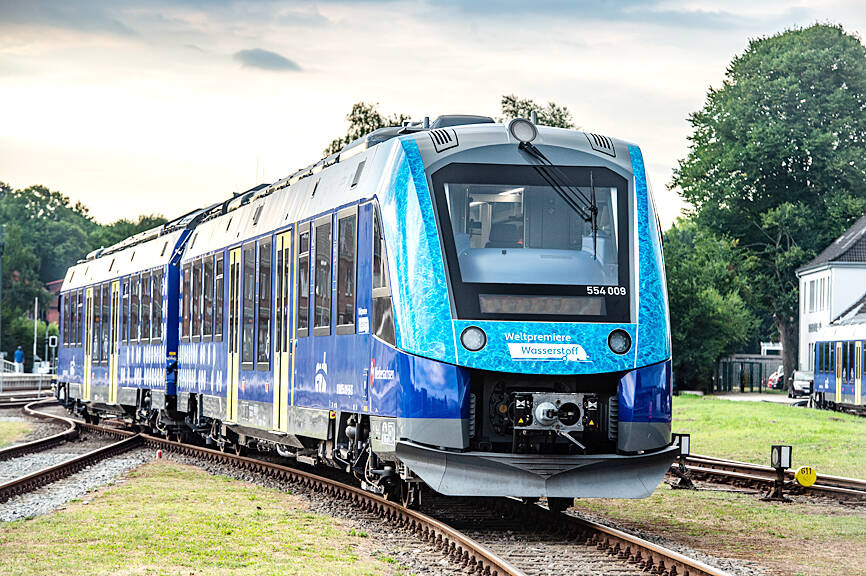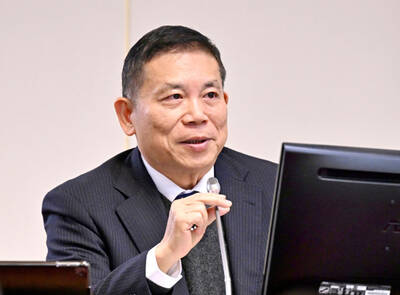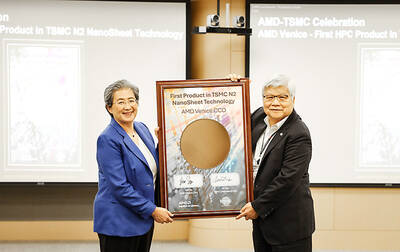Germany on Wednesday inaugurated a railway line powered entirely by hydrogen, a “world premiere” and a major step forward for green train transport, despite nagging supply challenges.
A fleet of 14 trains provided by French industrial giant Alstom SA to the German state Lower Saxony has replaced diesel locomotives on the 100km of track connecting the cities of Cuxhaven, Bremerhaven, Bremervoerde and Buxtehude near Hamburg.
“We are very proud to put this technology into operation together with our strong partners as a world premiere,” Alstom chief executive officer Henri Poupart-Lafarge said in a statement.

Photo: EPA-EFE / Alastom SA
Hydrogen trains have become a promising way to decarbonize the rail sector and replace climate-warming diesel, which still powers 20 percent of journeys in Germany.
Billed as a “zero emission” mode of transport, the trains mix hydrogen on board with oxygen present in the ambient air using a fuel cell installed in the roof. This produces the electricity needed to pull the train.
Regional rail operator Landesnahverkehrsgesellschaft Niedersachsen mbH said the fleet, which cost 93 million euros (US$92,7 million), would prevent 4,400 tonnes of carbon dioxide being released into the atmosphere each year.
RUN FOR ITS MONEY
Designed in the southern French town of Tarbes and assembled in Salzgitter in central Germany, Alstom’s trains — called Coradia iLint — are trailblazers in the sector.
The project created jobs for up to 80 employees in the two countries, Alstom said.
Commercial trials have been carried out since 2018 on the line with two hydrogen trains, but now the entire fleet is adopting the groundbreaking technology. The French group has signed four contracts for several dozen trains between Germany, France and Italy, with no sign of demand waning.
In Germany alone, “between 2,500 and 3,000 diesel trains could be replaced by hydrogen models,” Alstom project manager Stefan Schrank said.
“By 2035, around 15 to 20 percent of the regional European market could run on hydrogen,” said Alexandre Charpentier, a rail expert at consultancy Roland Berger.
Hydrogen trains are particularly attractive on short regional lines where the cost of a transition to electric outstrips the profitability of the route. Currently, about one out of two regional trains in Europe runs on diesel.
However, Alstom’s competitors are ready to give it a run for its money. German behemoth Siemens AG unveiled a prototype hydrogen train with national rail firm Deutsche Bahn AG in May, aiming to roll them out in 2024.
Yet despite the attractive prospects, “there are real barriers” to a big expansion with hydrogen, Charpentier said.
For starters, trains are not the only means of transport hungry for the fuel. The entire sector, whether it be road vehicles or aircraft, not to mention heavy industry such as steel and chemicals, is eyeing hydrogen to slash carbon dioxide emissions.
COLOSSAL INVESTMENT
Although Germany in 2020 announced an ambitious 7 billion euro plan to become a leader in hydrogen technologies within a decade, the infrastructure is still lacking in Europe’s top economy.
It is a problem seen across the continent, where colossal investment would be needed for a real shift to hydrogen.
“For this reason, we do not foresee a 100 percent replacement of diesel trains with hydrogen,” Charpentier said.
Furthermore, hydrogen is not necessarily carbon free: only “green hydrogen,” produced using renewable energy, is considered sustainable by experts. Other, more common manufacturing methods exist, but they emit greenhouse gases because they are made from fossil fuels.
The Lower Saxony line in the beginning would have to use a hydrogen by-product of certain industries such as the chemical sector.
The French research institute IFP, which specializes in energy issues, says that hydrogen is “95 percent derived from the transformation of fossil fuels, almost half of which come from natural gas.”
Europe’s enduring reliance on gas from Russia amid massive tensions over the Kremlin’s invasion of Ukraine poses major challenges for the development of hydrogen in rail transport.
“Political leaders will have to decide which sector to prioritize when determining what the production of hydrogen will or won’t go to,” Charpentier said.
Germany would also have to import massively to meet its needs. Partnerships have recently been signed with India and Morocco, and German Chancellor Olaf Scholz sealed a green hydrogen deal with Canada on a visit this week, laying a path for a transatlantic supply chain.

UNCERTAINTY: Innolux activated a stringent supply chain management mechanism, as it did during the COVID-19 pandemic, to ensure optimal inventory levels for customers Flat-panel display makers AUO Corp (友達) and Innolux Corp (群創) yesterday said that about 12 to 20 percent of their display business is at risk of potential US tariffs and that they would relocate production or shipment destinations to mitigate the levies’ effects. US tariffs would have a direct impact of US$200 million on AUO’s revenue, company chairman Paul Peng (彭雙浪) told reporters on the sidelines of the Touch Taiwan trade show in Taipei yesterday. That would make up about 12 percent of the company’s overall revenue. To cope with the tariff uncertainty, AUO plans to allocate its production to manufacturing facilities in

TAKING STOCK: A Taiwanese cookware firm in Vietnam urged customers to assess inventory or place orders early so shipments can reach the US while tariffs are paused Taiwanese businesses in Vietnam are exploring alternatives after the White House imposed a 46 percent import duty on Vietnamese goods, following US President Donald Trump’s announcement of “reciprocal” tariffs on the US’ trading partners. Lo Shih-liang (羅世良), chairman of Brico Industry Co (裕茂工業), a Taiwanese company that manufactures cast iron cookware and stove components in Vietnam, said that more than 40 percent of his business was tied to the US market, describing the constant US policy shifts as an emotional roller coaster. “I work during the day and stay up all night watching the news. I’ve been following US news until 3am

Taiwan will prioritize the development of silicon photonics by taking advantage of its strength in the semiconductor industry to build another shield to protect the local economy, National Development Council (NDC) Minister Paul Liu (劉鏡清) said yesterday. Speaking at a meeting of the legislature’s Economics Committee, Liu said Taiwan already has the artificial intelligence (AI) industry as a shield, after the semiconductor industry, to safeguard the country, and is looking at new unique fields to build more economic shields. While Taiwan will further strengthen its existing shields, over the longer term, the country is determined to focus on such potential segments as

COLLABORATION: Given Taiwan’s key position in global supply chains, the US firm is discussing strategies with local partners and clients to deal with global uncertainties Advanced Micro Devices Inc (AMD) yesterday said it is meeting with local ecosystem partners, including Taiwan Semiconductor Manufacturing Co (TSMC, 台積電), to discuss strategies, including long-term manufacturing, to navigate uncertainties such as US tariffs, as Taiwan occupies an important position in global supply chains. AMD chief executive officer Lisa Su (蘇姿丰) told reporters that Taiwan is an important part of the chip designer’s ecosystem and she is discussing with partners and customers in Taiwan to forge strong collaborations on different areas during this critical period. AMD has just become the first artificial-intelligence (AI) server chip customer of TSMC to utilize its advanced